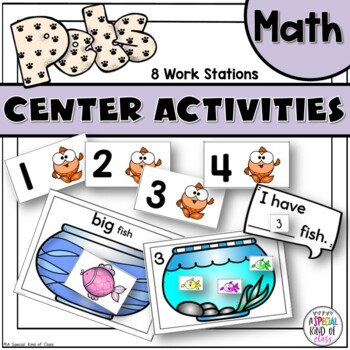Pet Math Centers for Kindergarten
- PDF
Description
If you are looking to supplement your Kindergarten or pre-K math centers with Pet activities, then this is the unit for you. These 8 math centers are intended to work on numbers 1 to 20 and fit perfectly with your Pet or animal theme.
Here’s what’s included:
- Fish sorting: Sort the fish by color and size
- Fish counting: Put the correct number of fish in each tank (numbers to 20)
- Pet patterns: Extend the pattern or make one of your own with the pets
- Dog bone printing: Practice printing numbers to 20
- 5 and 10 frames: How many fish are in the tanks? Use the frames to help you count (numbers to 10)
- More, less or the same: Give the hamster more, less or the same amount of food as his friend (numbers to 10)
- Adding and subtracting: Use the math mats to practice adding and subtracting
- Ordering numbers: Order the pets from 1 to 20
Works on:
- Counting
- Number recognition
- Printing
- Sorting (by size and color)
- Patterns
- 5 frames and 10 frames
- More, less and the same
- Adding
- Subtracting
- Ordering
These centers align to Common Core Standards:
K.CC.A.2 Count forward beginning from a given number within the known sequence (instead of having to begin at 1).
K.CC.A.3 Write numbers from 0 to 20. Represent a number of objects with a written numeral 0-20 (with 0 representing a count of no objects)
K.CC.B.4a When counting objects, say the number names in the standard order, pairing each object with one and only one number name and each number name with one and only one object.
K.CC.B.4b Understand the relationship between numbers and quantities; connect counting to cardinality.
K.CC.B.5 Count to answer “how many?” questions about as many as 20 things arranged in a line, a rectangular array, or a circle, or as many as 10 things in a scattered configuration; given a number from 1–20, count out that many objects.
K.CC.C.6 Identify whether the number of objects in one group is greater than, less than, or equal to the number of objects in another group, e.g., by using matching and counting strategies.
K.OA.A.5 Fluently add and subtract within 5.
K.MD.B.3 Classify objects into given categories; count the numbers of objects in each category and sort the categories by count.
Although the centers take a bit to print and put together, you will love them because once made up, you will have them for years to come. This resource is intended to be printed, laminated and put in baggies or containers for quick and easy set up.
****************************************************************************
More Pet Activities
Pet Literacy Work Station Activities.
*****************************************************************************
Customer Tips:
How to get TPT credit to use on future purchases:
• Please go to your My Purchases page (you may need to login). Beside each purchase you'll see a Provide Feedback button. Simply click it and you will be taken to a page where you can give a quick rating and leave a short comment for the product. Each time you give feedback, TPT gives you feedback credits that you use to lower the cost of your future purchases. I value your feedback greatly as it helps me determine which products are most valuable for your classroom so I can create more for you. ☺
Be the first to know about my new discounts, freebies and product launches:
• Click here to become a follower. Voila! You will now receive email updates about this store. ☺
*****************************************************************************





